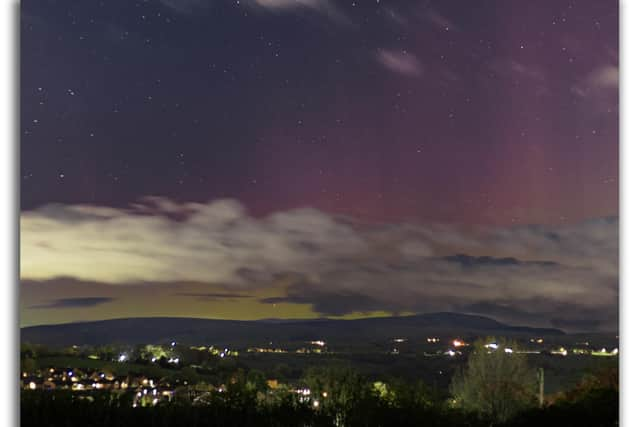Burnley photographer captures Northern Lights over Pendle Hill
and live on Freeview channel 276
Dave Lawrence took the shots from his home in Whitpark Grove on Wednesday night.
He said: "There was a lot of buzz around a big solar flare last week, that was predicted to hit over Halloween weekend and provide the strongest Aurora in years. People compared it to a famous event over Halloween back in 2003, where the lights were spotted as far South as Devon.
Advertisement
Hide AdAdvertisement
Hide Ad"Determined not to miss it, I spent the weekend in the darker skies of the Yorkshire Dales, only for the Aurora to change its mind in the final moments, and give us nothing.


"Fast forward to Wednesday and there was expectations of a minor event to arrive, due to some much smaller solar flares. The type of Aurora only visible in much higher latitudes.
"I was already in bed by 9-30pm when suddenly my phone started pinging with alerts of a strong Aurora in progress. I started daydreaming of the possibility of capturing the faintest green glow next to Pendle Hill, but determined even that was a long shot due to light pollution and our low latitude.
"Something compelled me to get dressed, pack my camera, and go around the corner of my house where I have a distant view of Pendle Hill. What greeted me was something I never thought possible. Not only was the green glow present on the horizon, but big red and pink light pillars directly above. I was shaking with excitement... and ok maybe partly because of the cold.
Advertisement
Hide AdAdvertisement
Hide Ad"Unfortunately I arrived just as the show was coming to an end and the clouds came in.
"I did manage to get a timelapse of the final remnants of lights, and was rewarded with a meteor afterwards. Towards the end of the video you see a plane zip from right to left, then a satellite move from North to South, followed by a quick meteor that enters above the clouds to the left.
"Solar activity comes in 11 year cycles, and this cycle has well and truly started with a bang. With the next peak due in 2024, we can only hope for similar or even stronger events to happen again soon.
"I caught the end of the Aurora and then as it died down the clouds came in. Towards the end of the clip, the clouds start to clear and you can see a few aircraft fly by, followed by a meteor that enters from the left."
Advertisement
Hide AdAdvertisement
Hide AdMeaning light of dawn, the term Aurora Borealis was first coined by Galileo in 1623 and is derived from ‘Aurora’, the goddess of the dawn and ‘Boreas’, the northern wind personified.
The Northern Lights and their counterpart in the southern hemisphere appear when highly charged solar wind particles flowing from the sun collide with air molecules in the earth’s atmosphere transferring their energy into light.
This occurs around the Polar Regions where those magnetic fields converge. These magnetic fields create auroral ovals around the top and bottom of our planet which move and distort as the earth rotates and solar flare activity increases.
Dave's other photography work can be seen at Facebook.com/dclawrencephotography
Comment Guidelines
National World encourages reader discussion on our stories. User feedback, insights and back-and-forth exchanges add a rich layer of context to reporting. Please review our Community Guidelines before commenting.